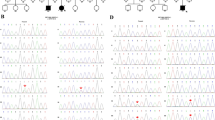Abstract
Purpose
Hirschsprung’s disease (HSCR) is a congenital disorder of the enteric nervous system characterized by the absence of ganglion cells in the Auerbach’s and Meissner’s plexuses. Although about 7% of cases are hereditary, the causal mutations have not been completely characterized. We encountered a novel family with inherited HSCR and screened them for causal mutations.
Methods
A Japanese family of five female patients and six unaffected individuals was subjected to a whole-exome analysis with a next-generation sequencer.
Results
After exome sequencing and the annotation of mutations, we identified co-segregated mutations with sequential filtering steps via a standard protocol. Eight mutations were identified: two on chromosome 10 and six on chromosome 11. We used pathogenicity prediction tools such as Genomic Evolutionary Rate Profiling, SIFT, and PolyPhen2 to predict the impact of mutations on the protein activity. S922Y, a novel mutation of RET, was identified as a likely causal mutation. In addition, a mutation of rs2435357T, known as enhancer of RET located in intron 1 of RET, was detected in this family.
Conclusion
The coexistence of RET mutations in both the exon (S922Y) and intron1 (rs2435357T) indicated a risk of HSCR in this family.



Similar content being viewed by others
References
Parisi MA, Kapur RP (2000) Genetics of Hirschsprung disease. Curr Opin Pediatr 12(6):610–617
Amiel J, Sproat-Emison E, Garcia-Barcelo M, Lantieri F, Burzynski G, Borrego S, Pelet A, Arnold S, Miao X, Griseri P, Brooks AS, Antinolo G, de Pontual L, Clement-Ziza M, Munnich A, Kashuk C, West K, Wong KK, Lyonnet S, Chakravarti A, Tam PK, Ceccherini I, Hofstra RM, Fernandez R, Hirschsprung Disease C (2008) Hirschsprung disease, associated syndromes and genetics: a review. J Med Genet 45(1):1–14. doi:10.1136/jmg.2007.053959
Taguchi T, Obata S, Ieiri S (2017) Current status of Hirschsprung’s disease: based on a nationwide survey of Japan. Pediatr Surg Int. doi:10.1007/s00383-016-4054-3
Mc Laughlin D, Puri P (2015) Familial Hirschsprung’s disease: a systematic review. Pediatr Surg Int 31(8):695–700. doi:10.1007/s00383-015-3730-z
Takahashi M, Ritz J, Cooper GM (1985) Activation of a novel human transforming gene, ret, by DNA rearrangement. Cell 42(2):581–588
Sancandi M, Ceccherini I, Costa M, Fava M, Chen B, Wu Y, Hofstra R, Laurie T, Griffths M, Burge D, Tam PK (2000) Incidence of RET mutations in patients with Hirschsprung’s disease. J Pediatr Surg 35(1):139–142 (discussion 142–133)
Wheeler DL, Barrett T, Benson DA, Bryant SH, Canese K, Chetvernin V, Church DM, DiCuccio M, Edgar R, Federhen S, Geer LY, Kapustin Y, Khovayko O, Landsman D, Lipman DJ, Madden TL, Maglott DR, Ostell J, Miller V, Pruitt KD, Schuler GD, Sequeira E, Sherry ST, Sirotkin K, Souvorov A, Starchenko G, Tatusov RL, Tatusova TA, Wagner L, Yaschenko E (2007) Database resources of the National Center for Biotechnology Information. Nucl Acid Res 35(Database issue):D5–D12. doi:10.1093/nar/gkl1031
Abecasis GR, Auton A, Brooks LD, DePristo MA, Durbin RM, Handsaker RE, Kang HM, Marth GT, McVean GA (2012) An integrated map of genetic variation from 1,092 human genomes. Nature 491(7422):56–65. doi:10.1038/nature11632
Davydov EV, Goode DL, Sirota M, Cooper GM, Sidow A, Batzoglou S (2010) Identifying a high fraction of the human genome to be under selective constraint using GERP ++. PLoS Comput Biol 6(12):e1001025. doi:10.1371/journal.pcbi.1001025
Kumar P, Henikoff S, Ng PC (2009) Predicting the effects of coding non-synonymous variants on protein function using the SIFT algorithm. Nat Protoc 4(7):1073–1081. doi:10.1038/nprot.2009.86
Adzhubei IA, Schmidt S, Peshkin L, Ramensky VE, Gerasimova A, Bork P, Kondrashov AS, Sunyaev SR (2010) A method and server for predicting damaging missense mutations. Nat Methods 7(4):248–249. doi:10.1038/nmeth0410-248
George Priya Doss C, Rajith B, Chakraboty C, Balaji V, Magesh R, Gowthami B, Menon S, Swati M, Trivedi M, Paul J, Vasan R, Das M (2014) In silico profiling and structural insights of missense mutations in RET protein kinase domain by molecular dynamics and docking approach. Mol BioSyst 10(3):421–436. doi:10.1039/c3mb70427k
Takahashi M (2001) The GDNF/RET signaling pathway and human diseases. Cytokine Growth Factor Rev 12(4):361–373
Schuchardt A, D’Agati V, Larsson-Blomberg L, Costantini F, Pachnis V (1994) Defects in the kidney and enteric nervous system of mice lacking the tyrosine kinase receptor Ret. Nature 367(6461):380–383. doi:10.1038/367380a0
Uesaka T, Nagashimada M, Yonemura S, Enomoto H (2008) Diminished Ret expression compromises neuronal survival in the colon and causes intestinal aganglionosis in mice. J Clin Invest 118(5):1890–1898. doi:10.1172/jci34425
Kitamura Y, Scavarda N, Wells SA Jr, Jackson CE, Goodfellow PJ (1995) Two maternally derived missense mutations in the tyrosine kinase domain of the RET protooncogene in a patient with de novo MEN 2B. Hum Mol Genet 4(10):1987–1988
Emison ES, McCallion AS, Kashuk CS, Bush RT, Grice E, Lin S, Portnoy ME, Cutler DJ, Green ED, Chakravarti A (2005) A common sex-dependent mutation in a RET enhancer underlies Hirschsprung disease risk. Nature 434(7035):857–863. doi:10.1038/nature03467
Kashuk CS, Stone EA, Grice EA, Portnoy ME, Green ED, Sidow A, Chakravarti A, McCallion AS (2005) Phenotype-genotype correlation in Hirschsprung disease is illuminated by comparative analysis of the RET protein sequence. Proc Natl Acad Sci USA 102(25):8949–8954. doi:10.1073/pnas.0503259102
Emison ES, Garcia-Barcelo M, Grice EA, Lantieri F, Amiel J, Burzynski G, Fernandez RM, Hao L, Kashuk C, West K, Miao X, Tam PK, Griseri P, Ceccherini I, Pelet A, Jannot AS, de Pontual L, Henrion-Caude A, Lyonnet S, Verheij JB, Hofstra RM, Antinolo G, Borrego S, McCallion AS, Chakravarti A (2010) Differential contributions of rare and common, coding and noncoding Ret mutations to multifactorial Hirschsprung disease liability. Am J Hum Genet 87(1):60–74. doi:10.1016/j.ajhg.2010.06.007
Author information
Authors and Affiliations
Corresponding author
Ethics declarations
Conflict of interest
No competing financial interests exist.
Rights and permissions
About this article
Cite this article
Kawano, T., Hosomichi, K., Inoue, I. et al. Identification of a novel variant of the RET proto-oncogene in a novel family with Hirschsprung’s disease. Pediatr Surg Int 33, 1041–1046 (2017). https://doi.org/10.1007/s00383-017-4134-z
Accepted:
Published:
Issue Date:
DOI: https://doi.org/10.1007/s00383-017-4134-z




